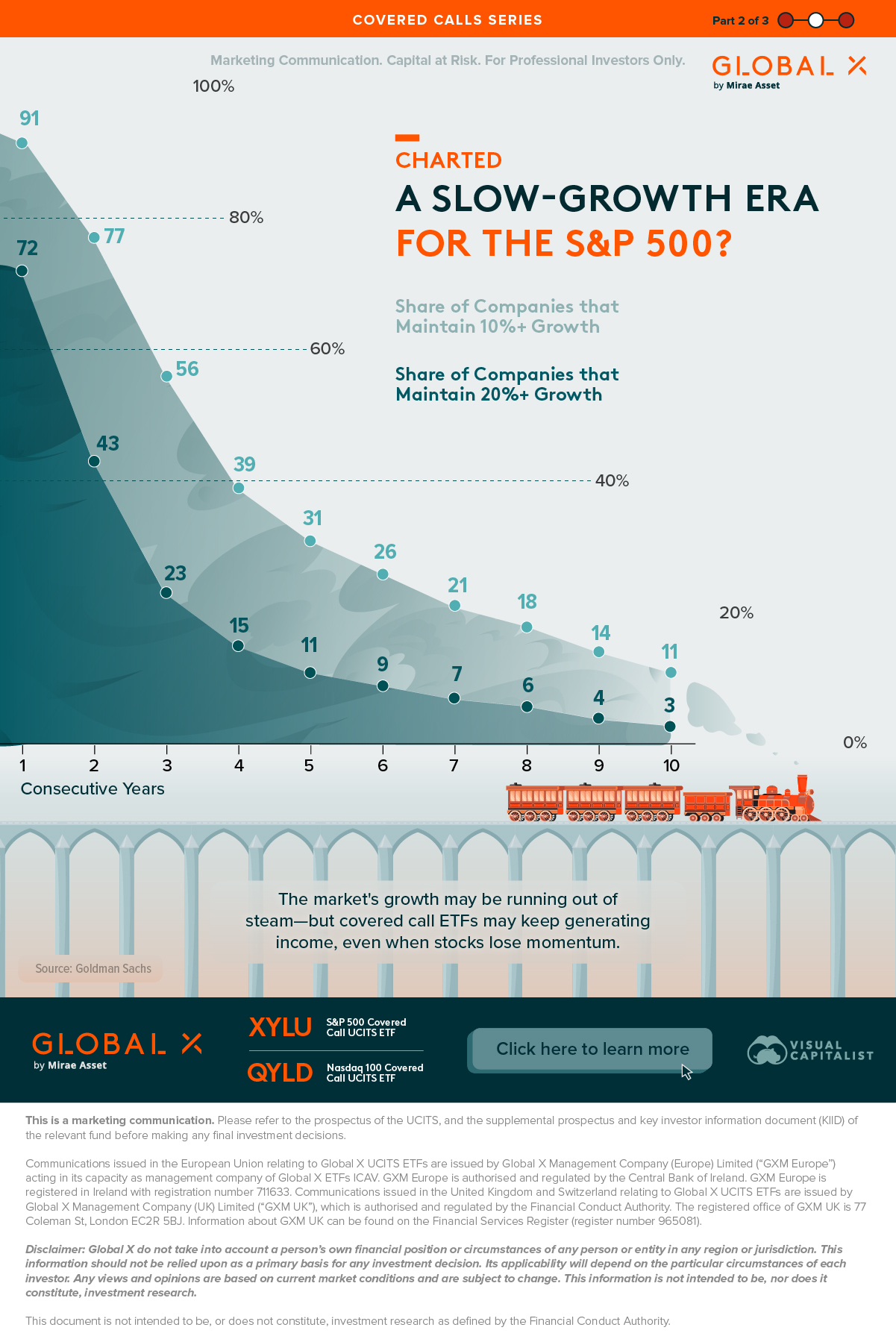Charted: A Slow-Growth Era for the S&P 500?
The S&P 500 delivered impressive gains in 2023 and 2024, and is on pace to climb nearly 10% in 2025. But how much longer can this momentum last?
In partnership with Global X, this visualization illustrates why the index may be approaching a slower-growth phase. Using data from Goldman Sachs, it highlights how the share of companies able to sustain 10%+ annual growth shrinks dramatically as the number of consecutive years increases.
What Is the S&P 500?
The S&P 500 is a leading U.S. stock market index that tracks the performance of approximately 500 of the largest publicly traded companies in the United States. It is capitalization-weighted, meaning companies with larger market caps have a bigger influence on the index’s movement.
As of September, the S&P 500 was up nearly 10% for the year. If this pace holds, it would mark the index’s third straight year of robust gains—and its eighth out of the past 10.
Consecutive Years of Growth
Bull markets—periods characterized by sustained rising prices—can lose momentum over time. One insightful way to analyze this is by examining the share of companies that consistently achieve high growth over time.
It’s remarkably common for companies to achieve 10% or more growth in a single year—Goldman Sachs research shows that up to 91% of firms may reach that threshold at some point (for at least one consecutive year). However, it’s extraordinarily rare for companies to sustain that pace annually over long periods of time.
When you extend the window to 10 consecutive years, the share drops sharply to only about 11%. This steep decline underscores how maintaining double-digit growth long-term is exceptionally difficult.
| Consecutive Years | Share of Companies that Maintain 10%+ Growth (%) | Share of Companies that Maintain 20%+ Growth (%) |
|---|---|---|
| 1 | 91 | 72 |
| 2 | 77 | 43 |
| 3 | 56 | 23 |
| 4 | 39 | 15 |
| 5 | 31 | 11 |
| 6 | 26 | 9 |
| 7 | 21 | 7 |
| 8 | 18 | 6 |
| 9 | 14 | 4 |
| 10 | 11 | 3 |
This trend is also true in the 20%-plus growth category as well. The share of companies able to maintain that for one year sits around 72% and then drops dramatically to 3% after 10 consecutive years.
Investing in Covered Calls
Investing in a covered call ETF can provide investors with an additional layer of income and diversification. This could be especially valuable if the S&P 500 were to enter a slower growth phase.
By writing call options on the stocks it holds, a covered call ETF generates option premiums that are paid out to investors. This helps to cushion returns when equity gains moderate.
This strategy not only broadens a portfolio beyond simple price appreciation but also offers a potential buffer against volatility.

Learn more about the Global X Nasdaq 100 Covered Call UCITS ETF (QYLD) and the Global X S&P 500 Covered Call UCITS ETF (XYLU).
-
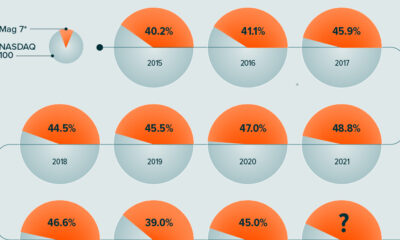
 Markets1 day ago
Markets1 day agoVisualised: Magnificent 7 Concentration in the Nasdaq 100 Over Time
The Nasdaq 100, a key benchmark for U.S. technology companies, is remarkably concentrated. Just seven stocks make up nearly 40% of the entire index.
-

 Markets1 day ago
Markets1 day ago3 Things to Know About Covered Call Options
Covered call option ETFs offer investors a unique way to generate income—but what exactly are they, and when do they tend to perform best?
-

 Economy2 months ago
Economy2 months agoRanked: Which European Sectors Need the Most Investment?
European infrastructure is under pressure—but not all sectors are being hit equally. Which ones need the most investment in coming years?
-

 Economy2 months ago
Economy2 months agoCharted: Europe’s $2 Trillion Infrastructure Investment Deficit
This graphic, created in partnership with Global X, offers visual context to Europe’s widening infrastructure investment gap, using data from Infrastructure Outlook.
-

 Economy2 months ago
Economy2 months agoBreaking Down the €286 EU Billion Infrastructure Spend
This visualization, created in partnership with Global X, offers a clear look at where RRF grants and loans are being directed in the EU, based on…
-

 Politics2 months ago
Politics2 months agoBreaking Down the West’s $146 Billion 2024 Defence Technology Investment
Visual Capitalist has partnered with Global X ETFs to break down the $146 billion spent on defence technology by the U.S. and the EU.
-
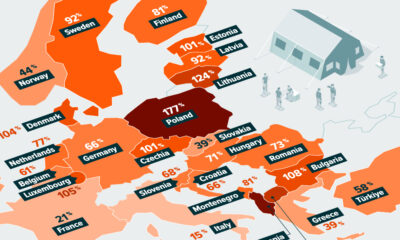
 Politics2 months ago
Politics2 months agoMapped: How NATO Defence Spending Has Changed Since the Ukraine-Russia War
Visual Capitalist has partnered with Global X ETFs to explore how NATO defence spending has changed since the start of the Ukrain-Russia war.
-

 Politics2 months ago
Politics2 months agoVisualized: Global Defence Spending in 2024
Visual Capitalist has partnered with Global X ETFs to explore global defence spending and find out which nation spends the most on defence.
-

 Economy3 months ago
Economy3 months agoBreaking Down the 117th Congress’s $1.2T Infrastructure Investment
Graphic showing U.S. infrastructure investment highlighting that investment is primarily going to roads, bridges, and other major projects.
-

 Economy3 months ago
Economy3 months agoReport Card: Grading U.S. Infrastructure
This graphic shows U.S infrastructure grades and highlights the general low grade.
-
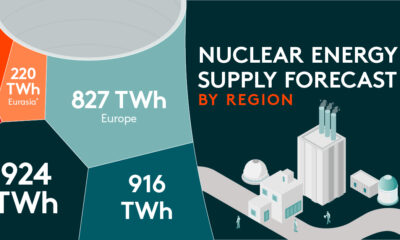
 Energy8 months ago
Energy8 months agoNuclear Energy Supply Forecast by Region
Visual Capitalist and Global X partnered to explore global nuclear energy demand, and how it’s changing, in the coming years.
-
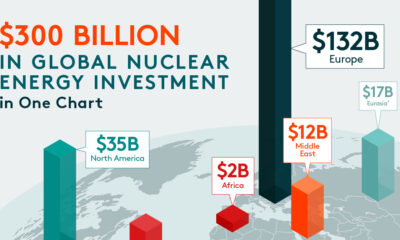
 Energy8 months ago
Energy8 months agoCharted: $300 Billion in Global Nuclear Energy Investment
Visual Capitalist and Global X partnered to explore nuclear energy investment and find out which regions spent the most on nuclear power.
-
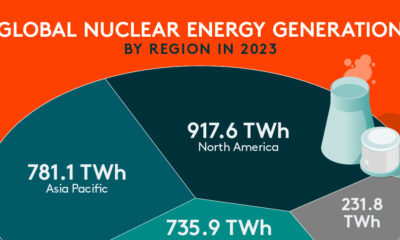
 Energy8 months ago
Energy8 months agoVisualized: Nuclear Energy Generation by Region
Visual Capitalist and Global X ETFs explore regional nuclear energy generation and why nuclear energy is critical to the energy transition.
-

 Technology11 months ago
Technology11 months agoRanked: Which Countries Have the Most Data Centers?
For this graphic, Visual Capitalist partnered with Global X ETFs to rank the nations by the number of data centers they currently operate.
-

 Technology11 months ago
Technology11 months agoCharted: How Much Data is Stored Online?
For this graphic, Visual Capitalist has partnered with Global X ETFs to explore online data generation and show how much data could be generated between 2015…
-
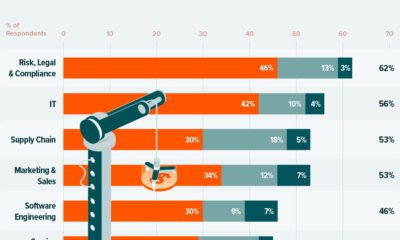
 Technology11 months ago
Technology11 months agoVisualized: The Impact of AI on Revenue
In this graphic, Visual Capitalist has partnered with Global X ETFs to explore the financial impact of AI adoption across various industries.
-

 Green2 years ago
Green2 years agoMapped: U.S. Investment in Sustainable Infrastructure (2021-2023)
This graphic shows high levels of investment in U.S. clean infrastructure between 2021 and 2023.
-

 Technology2 years ago
Technology2 years agoVisualized: What is the Artificial Intelligence of Things?
Explore the explosive growth of the Artificial Intelligence of Things (AIoT) industry and its transformative impact across sectors.
-

 Technology2 years ago
Technology2 years agoA Visual Guide to AI Adoption, by Industry
AI adoption impacts many industries, with finance leading. Discover how AI tools optimize operations, mitigate risks, and drive growth.
-

 Technology2 years ago
Technology2 years agoRanked: Artificial Intelligence Startups, by Country
Find out which countries are winning the race when it comes to the number of AI startups and private investment .
-

 Technology3 years ago
Technology3 years agoOn the Road to Electric Vehicles
Electric vehicles are playing a key role in the decarbonization of road transport. But how much further do we need to go to hit net zero?
-

 Mining3 years ago
Mining3 years agoShould You Invest in Disruptive Materials?
Disruptive materials are experiencing a demand supercycle. See how these materials are helping revolutionize next generation technologies.
-

 Technology3 years ago
Technology3 years agoThematic Investing: 3 Key Trends in Cybersecurity
Cyberattacks are becoming more frequent and sophisticated. Here’s what investors need to know about the future of cybersecurity.




